This ultimate guide to fermentation troubleshooting will answer all of your fermenting FAQs… including why your ferment isn’t bubbling, what to do if your ferment is mushy or moldy, how to tell if your ferment is done, safety tips, and more.
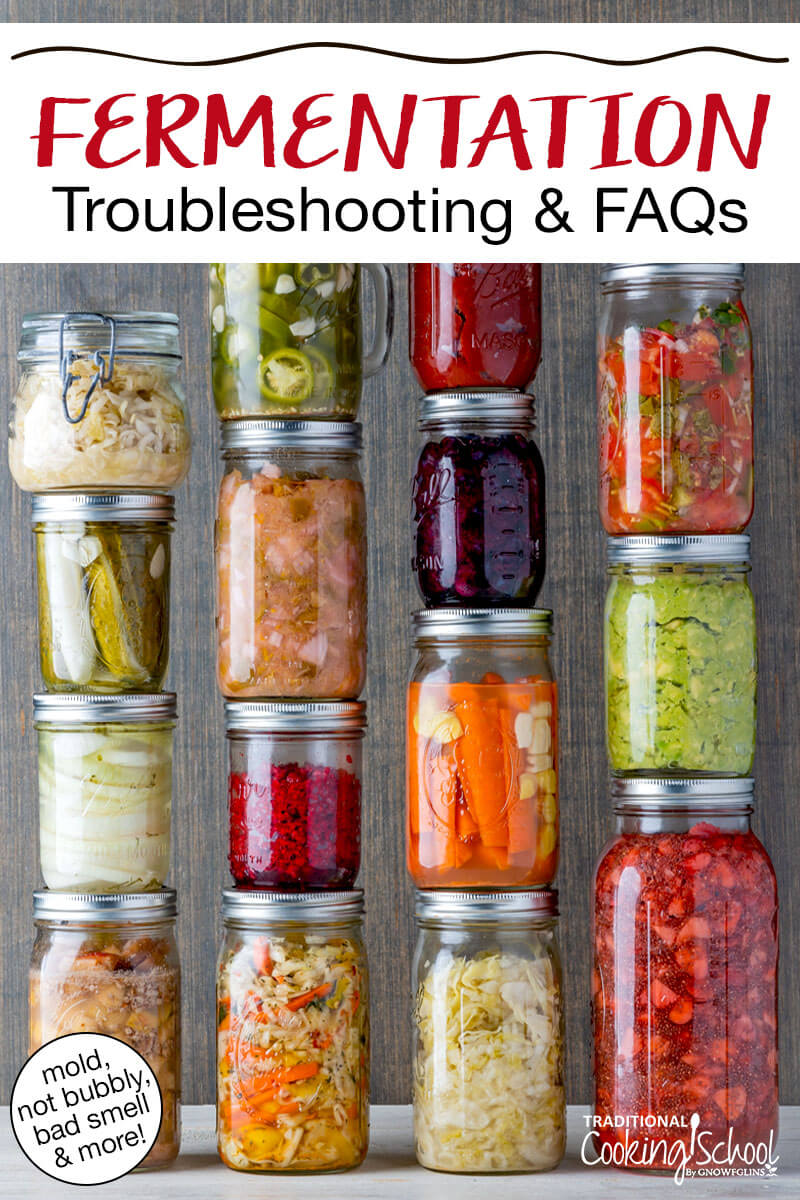
Even though fermentation is safe and has been done since the beginning of time…
Even though you can do it at home, and you don’t need really special equipment…
…fermentation problems do come up now and then.
So today we’re all about troubleshooting ferments. Whether it’s not bubbling, it’s mushy, or you plain and simple just don’t like it.
Questions include:
- Why isn’t my ferment bubbling?
- What to do if your ferment is moldy.
- How can I tell if my ferment is done?
- I’m dairy-free. Can I use something other than whey?
- and many more fermentation troubleshooting tips!
Don’t have time to listen or watch? The complete transcript of fermenting FAQs is below, too.
Table Of Contents
Fermentation Troubleshooting
Subscribe to the Know Your Food with Wardee podcast on iTunes, Stitcher, YouTube, or the Podcasts app. For past or current episodes, check out the Know Your Food with Wardee podcast archives.
What Is Fermenting?
First, let’s get on the same page. What is fermenting?
Most of us think about fermentation in terms of vegetables, like sauerkraut or pickles. But you can ferment virtually anything: fruit and veggies into chutney, relish, pickles, salsa, and other condiments; grains through sourdough; dairy into milk kefir, yogurt, cheeses, and more; beans into hummus, natto, and tempeh; meats into sausage and other cured meats; even beverages like water kefir and Kombucha!
Although there are differences depending on what you’re fermenting, the basic fermentation process goes like this.
Sea salt and/or whey are added to food and left at room temperature for a few days to a few weeks. The naturally present organisms on the fruits and vegetables will begin to feast on the starches and sugars in the foods. And as they do that, they will multiply.
They’ll also produce enzymes, vitamins, beneficial acids, even gases — that’s how you get bubbly ferments.
The final result is a naturally preserved food because the huge population of beneficial organisms repels spoiling organisms. Fruits and vegetables are wonderful, but if you ferment them, you make them better!
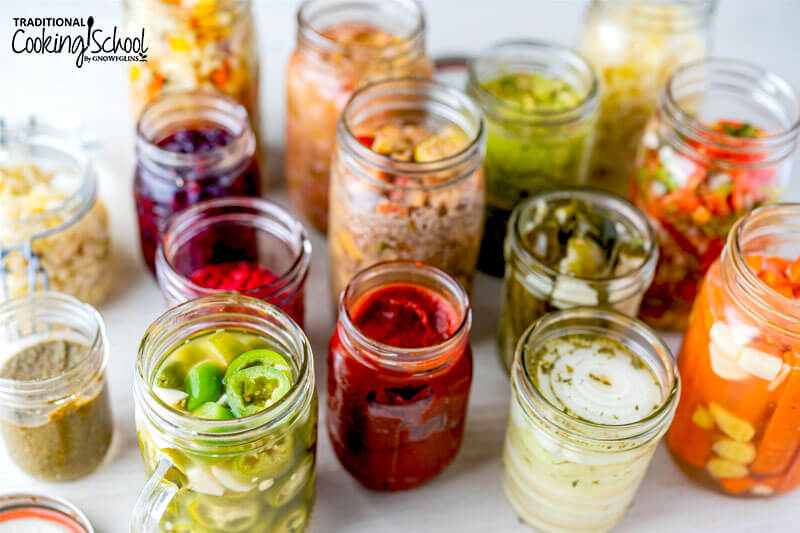
Safety Tips
Fermentation is safe. You can do it at home without special equipment. It’s been done since the beginning of time!
According to U.S. Department of Agriculture microbiologist Fred Bright,
“As far as I know, there has never been a documented case of food-born illness from fermented vegetables. Risky is not a word I would use to describe vegetable fermentation. It is one of the oldest and safest technologies we have.”
Yet fermentation problems do come up now and then, so let’s cover some basic safety tips.
- Practice cleanliness. Keep your containers, utensils, and counter tops clean. Wash your hands.
- Use organic produce so pesticides don’t mess with the natural processes.
- Source a high quality sea salt. I like Redmond’s Real Salt. It’s an unrefined salt with lots of color so you know it hasn’t been bleached or fortified with chemicals. Ferments love salt, and especially unrefined salt because they flourish with the extra minerals.
- Use uncontaminated, pure water. The beneficial bacteria and yeasts in ferments may have trouble thriving in water contaminated with chlorine, chloramine, or flouride (among thousands of other contaminants found in city water). If your water is not clean or you don’t filter it, I recommend purchasing spring water or filtered water (here’s how to choose the best water filter for your family!). If your water is filtered and does not re-add minerals back, consider fortifying it with natural mineral drops. I discuss using reverse osmosis water for sourdough in this #AskWardee.
Fermenting FAQs
A lot of fermenting questions have made their way into my inbox over the years. I’ve compiled the most common issues and solutions here for you!
Can I reduce the salt in any of Traditional Cooking School’s recipes?
No, salt protects ferments from spoiling organisms while allowing the Lactobacilli bacteria necessary for proper fermentation to thrive. It’s essential, in the amounts written, for safe fermentation.
My ferment tastes too salty. Is there anything I can do?
The saltiness can mellow once you put it in the fridge. Otherwise, if it’s still too salty, you can rinse it (sauerkraut, carrot sticks, etc.) before eating… or enjoy a small portion of these condiment-type fermented foods as a side for something less seasoned.
For instance, enjoy homemade kimchi with eggs or rice, or homemade sauerkraut with potatoes or steak, and perhaps hold off on salting these other foods entirely until you see if the ferment will be salty enough for it all.
I’m dairy-free. Is there another starter culture I can use instead of whey?
With most fruit ferments, you need a starter culture. Usually I use whey for a starter culture. If you don’t have whey, don’t want to use it, or wish to be dairy-free, we recommend a purchased veggie starter culture such as this one from Homesteader Supply.
If using the single-strength starter culture, add this to your ferments in place of whey at the rate of 1/16 teaspoon per quart of ferment. Mix the powdered culture with the same amount of filtered water as whey is called for. For instance, if the recipe calls for 1/4 cup of whey for a quart of ferment, then mix 1/16 teaspoon with 1/4 cup filtered water and add that to the recipe in place of the whey.
You can also use either finished water kefir (or even extra hydrated water kefir grains) or Kombucha.
In vegetable and other fermentation, you may also use these non-dairy options as well as just using additional sea salt.
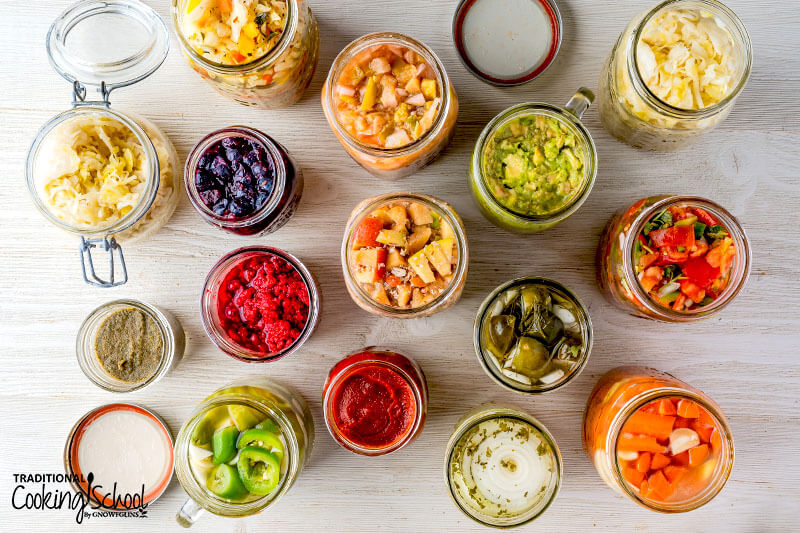
Is there really an advantage to buying a starter culture rather than using a food (water kefir, Kombucha, etc.) with active cultures to inoculate a ferment?
The advantage to using starter cultures is, if they are new and not degraded from being stored too hot or something, you can ensure a better result. Having said that, either can be used, and if one option is much more economical for you, you can go with that!
Can I use frozen fruits or vegetables in my ferments, instead of fresh?
Typically you don’t get good results with frozen fruits or vegetables. They will ferment but the texture is not good, unless making a paste. I would use fresh produce for most recipes.
What are the different “types” of ferments that need to be separated by at least 5 feet to prevent cross-contamination?
The main ones are: veggie/fruit ferments, cultured dairy, and sourdough. Beyond the different types, you would also want to separate ferments if they use different starter cultures, for example whey and water kefir. More information here.
If two lacto-ferments are typically different types but in this case I used the same starter culture for both of them, do I have to keep them 5 feet apart?
Great question! If ferments are started with the same culture, even if they’re different types, it’s okay to keep them in close proximity.
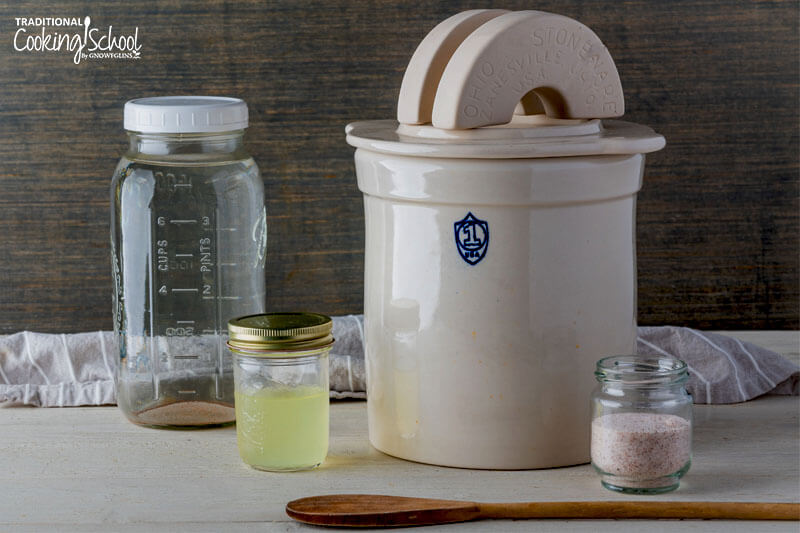
Do I need any type of special fermenting lid, such as an airlock or Pickle Pipe, to ferment?
No, you can use a Mason jar with a metal band and lid. Keep in mind that you should burp your ferments at least daily to prevent a build-up of gases.
Why isn’t my ferment bubbling?
Ferments bubble to varying degrees. Both pickles and sauerkraut tend to bubble a lot. Foods like apple chutney and ketchup are thick mixtures that may not bubble as much.
Even if your ferment usually bubbles but this batch isn’t, don’t toss it out! Look for other signs of fermentation, such as texture changes, color changes, and the whole mixture starting to develop sourness from the lactic acid that’s produced.
If you’re seeing these signs, all is well. If you’re not, is your ferment kept in a warm enough place to allow the beneficial bacteria to thrive?
What can I do to keep my ferment warm enough?
Most fermentation happens best around room temperature, or 72 degrees Fahrenheit. If your house is on the cool side, here’s what you can do to keep your ferment happy and the beneficial bacteria thriving:
- Insulate your ferment by wrapping it in towels.
- Keep your ferment on a seedling warming mat.
- Keep your ferment on top of a warm appliance, such as the fridge.
This #AskWardee has even more ideas for you!
My ferment smells bad… is it still safe to eat?
Before you start troubleshooting, know that many people aren’t used to the sour taste and smell of normal fermentation, so what is actually fine can be very off-putting at first. I recommend getting hands-on with your ferment. Open up the jar or crock and see how it’s doing every day — smell it, taste it, and the more you learn, the more you’ll know for future fermentation.
Wait until the initial gases have dispersed before smelling your ferment. The first puff of air is often stronger smelling than the rest, and you want an accurate sense of how the ferment is doing.
Does it smell sour, acidic, and a little bit yeasty? That’s normal and a sign of a healthy ferment.
Does it smell excessively yeasty, alcoholic, metallic or like paint thinner? This is a common problem when your ferment is too warm. Most fermentation should be done at room temperature, around 72 degrees Fahreheit. If you’re getting into the high 80s or 90s, move your ferment to a cooler location. Use your air conditioning. Or, postpone fermenting for cooler weather!
If it smells rotten and disgusting, then it has spoiled. Toss it.
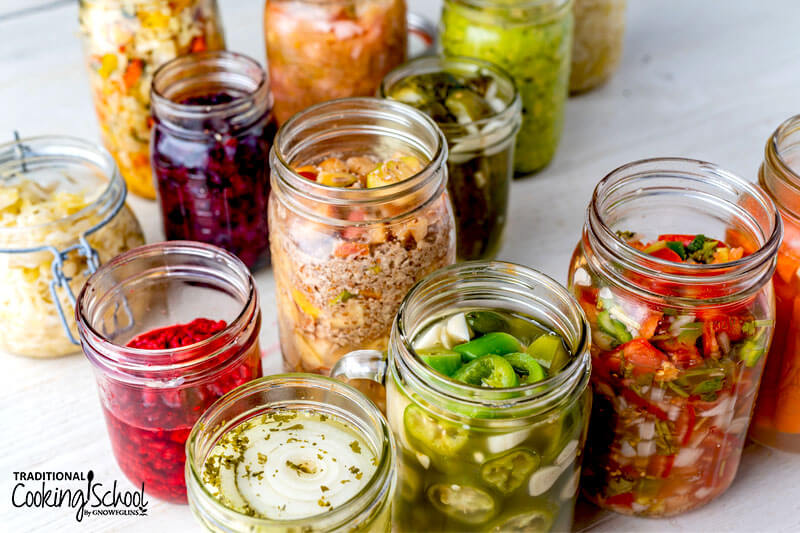
My ferment tastes bad. What should I do?
As mentioned above, ferments are an acquired taste for many people.
So, unless your ferment tastes rotten (in that case, toss it!), give yourself time to adjust. If you don’t like it the first time, that’s okay; don’t assume you’re never gonna like it. Try again in a week or two.
There is something you can do about the taste, though. If you’re tasting a ferment that just finished, try moving it to cold storage for a while before trying it again. The activity of the organisms will slow down, but the ferment will continue to age. Often, aging leads to mellowed out flavors: a different complexity, even less saltiness.
How can I tell if my ferment is spoiled or not?
Trust your nose! Though be aware that if it repels you but is not spoiled, it might be because you’re unaccustomed to fermented foods and need time to adjust to a new normal. If you aren’t sure, you can take a little taste and see how it goes. It’s always okay to be on the safe side and compost the ferment or feed the chickens with it.
Here are signs your ferment is on the right track:
- It’s sour and salty, both in taste and smell.
- It has a pleasant tang. It develops a complex sour and salty flavor over time.
- It’s crisp or crunchy, depending on the food your fermenting — like pickles or kraut.
- It may be sour, but not repelling.
- It may give off a strong odor when opened, but that dissipates. The odor was from pent-up gasses.
Here are hard and fast signs that a ferment has gone wrong:
- It’s moldy. Pink, blue or green and fuzzy is not good.
- It’s mushy. Who wants mushy vegetables like pickles or kraut?
- Its smell repels you because it’s putrid or rotten, not just sour. Your nose KNOWS this!
- When you taste it, it gives you an upset stomach.

I see mold in/on my ferment. Is it safe to eat if I skim it away, or should I toss the whole thing?
It depends. Little patches or a thin layer of mold is fine to skim away. If you have mold tendrils throughout your ferment, you’d better toss it. Sometimes you may not be able to see the mold tendrils, so skim away the top layer, let the air dissipate, then taste or smell what’s left. If it tastes or smells rotten, it is.
Remember that mold is relatively normal — the molds in the air can grow right at the top of ferments. They usually don’t go any deeper, as long as the salt brine is sufficiently acidic or the organisms in the ferment strong enough a colony. Just skim the ferment when needed. As a general rule, let your nose be your guide. If the fermenting food smells spoiled, it probably is. Toss it.
Also, mold is gray, pink, blue or green and fuzzy. If what you think is mold is flat instead of fuzzy, it’s probably kahm yeast — a white grayish yeast growth that looks like a dusty layer on top. It’s not harmful, but can cause off-flavors. It’s due to too much oxygen.
Here are a few factors that can lead to moldy ferments. Troubleshooting one or more of them should help you get your fermentation game back on track!
- too much air getting in and out of the fermenting vessel (most ferments need to be airtight)
- not completely submerged in brine (pack your ferment down or try a fermenting weight!)
- not enough salt (salt inhibits growth of bad bacteria)
- too warm (fermentation happens best at around 72 degrees Fahrenheit)
I covered how to prevent moldy ferments in this #AskWardee.
Is it normal for my ferment to be discolored on top?
Yes, that is normal in ferments, no need for further troubleshooting! It happens at the top of the jar or crock where there might be more exposure to air. As long as there is no mold, it is fine.
Why is my ferment mushy?
If your ferment is mushy instead of crunchy and crisp, you can try a few things.
- Replace the whey. Whey doesn’t always lead to mushy ferments, but it sometimes can. Try using a veggie starter culture such as this one next time, or skip the starter culture altogether if you’re making a vegetable ferment.
- Try increasing the salt. Salt is key for crunchiness.
- Double check your seals. If you’re fermenting in jars where the air is getting in and out, the extra oxygen can lead to mushiness. Source crocks that seal completely, try an airlock lid, or use a Fido jar. I share the pros and cons of different fermentation vessels here.
- Pack it carefully. Open your jar every day or as needed to pack the contents back down. A happy, bubbly ferment has air pockets which can lead to mushiness if not packed down.
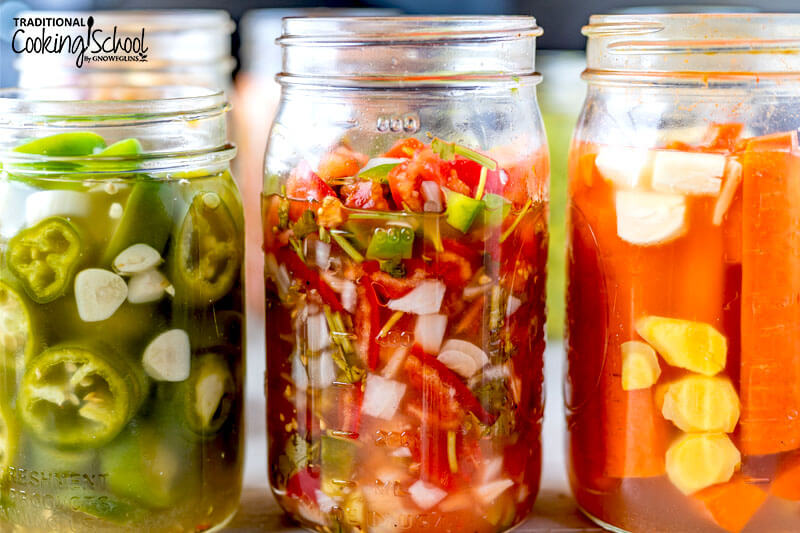
My ferment is dry — it doesn’t have enough liquid to submerge the mixture. What should I do?
Tamp the mixture down as far as it will go. Dissolve 1 teaspoon of a mineral-rich salt into 1/2 cup of pure, uncontaminated water, and pour to cover.
My ferment is producing way too much liquid — it leaked and spilled everywhere. What should I do?
First, tamp the mixture back down. If there isn’t enough brine left to submerge the mixture, simply dissolve 1 teaspoon of a mineral-rich salt into 1/2 cup of pure, uncontaminated water, and pour to cover.
Can I drain the liquid away after my ferment has finished fermenting?
No, we don’t recommend draining any of the liquid away. Even once the ferment is done and in the fridge, it’s important to keep the foods submerged and packed properly.
Instead, if you don’t like the extra liquid, I would use a slotted spoon to serve, leaving any extra liquid behind in the jar to stay with the remaining ferment. That’s often what I do, and then the extra juice can be drunk (after the rest of the ferment is gone) or used again for fermenting (such as sauerkraut juice)!
My ferment won’t stay down. What should I do?
Every day, tamp it back down to release the air bubbles lifting the mixture up. You want to keep it submerged. Feel free to use fermentation weights to help, or even half of an apple wedged down into the jar to keep the mixture covered by brine.
The brine for my ferment has turned cloudy. Is that normal?
Yes, totally normal! It’s a good sign!
Help! What is this sediment at the bottom of my ferment?
That is completely normal and a sign of good fermenting! Just a normal part of the process!
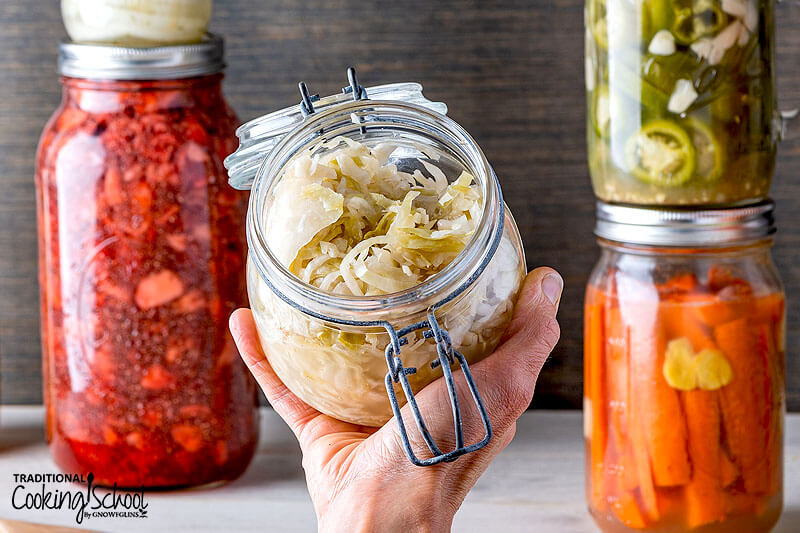
How can I tell if my ferment is done?
Go ahead and open it up and smell and taste it! No two ferments are going to be exactly alike — this is a flexible process and you really have to open the jar and dig in to see what’s going on in there. Typical signs of a finished ferment are:
- dimming or brightening of food colors
- sour taste (from acids produced)
- softening of foods (but hopefully still crunchy)
- flavor complexity – think of sauerkraut or pickles
I need help with a specific ferment! What should I do?
From fruit and veggie ferments to sourdough, beverages to cultured dairy, we have many articles to help with troubleshooting specific ferments! If you don’t see the ferment you’re looking for, we’re always adding more so check back soon.
- Sourdough FAQs
- Water Kefir FAQs
- Kombucha FAQs
- Dairy Kefir FAQs
- Beet Kvass FAQs
- Sauerkraut FAQs
- Pickled Radishes FAQs
- Cream Cheese FAQs
- Sour Cream FAQs
- Cultured Butter FAQs
- Whey FAQs
Fermenting Cheat Sheet
If you’re really excited about fermentation, I have a free gift for you! Pick it up here. It’s a quick guide where I go through formulas for fermenting.
For instance, if you want to make a quart of pickles or salsa, I give you all the amounts needed: this many vegetables, this amount of salt, this much brine, etc.!
A formula allows you to use whatever you have on hand to create a foolproof recipe. I also provide some basic guidelines for fermenting so that you can make delicious, healthy, and safe ferments. Click here for your copy.
Links Mentioned
- Free Fermenting Formulas Cheat Sheet
- Pickle Pro Airlock Lids
- The Complete Idiot’s Guide to Fermenting Foods — my book
- Allergy-Free Cooking eCourse
- Pickle Pro fermenting lids
- Fido jar
- Redmond’s Real Salt
Did you find these fermentation troubleshooting tips helpful? Do you have any more fermenting questions we can answer? If so, feel free to leave a comment below!
We only recommend products and services we wholeheartedly endorse. This post may contain special links through which we earn a small commission if you make a purchase (though your price is the same).


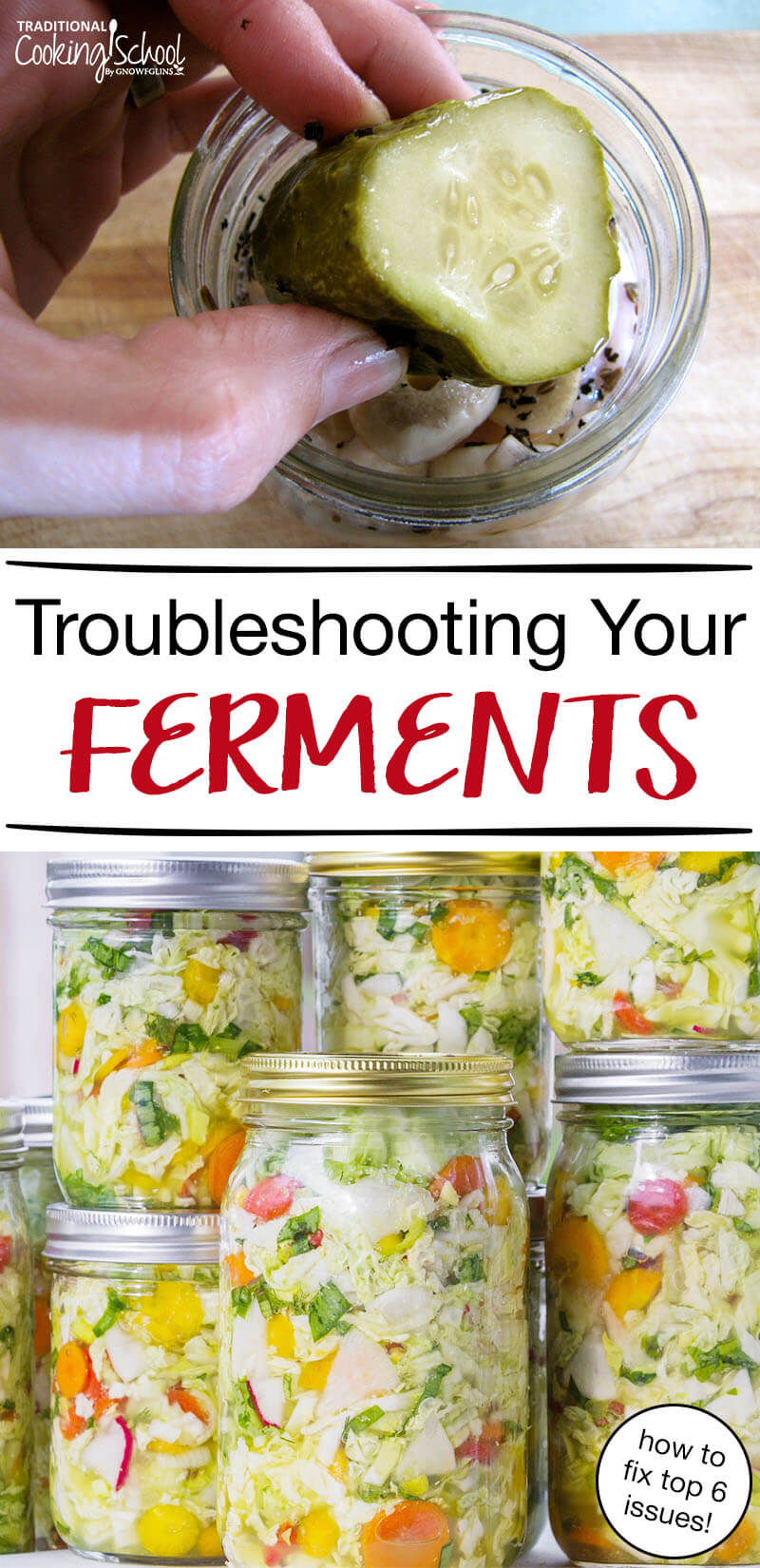
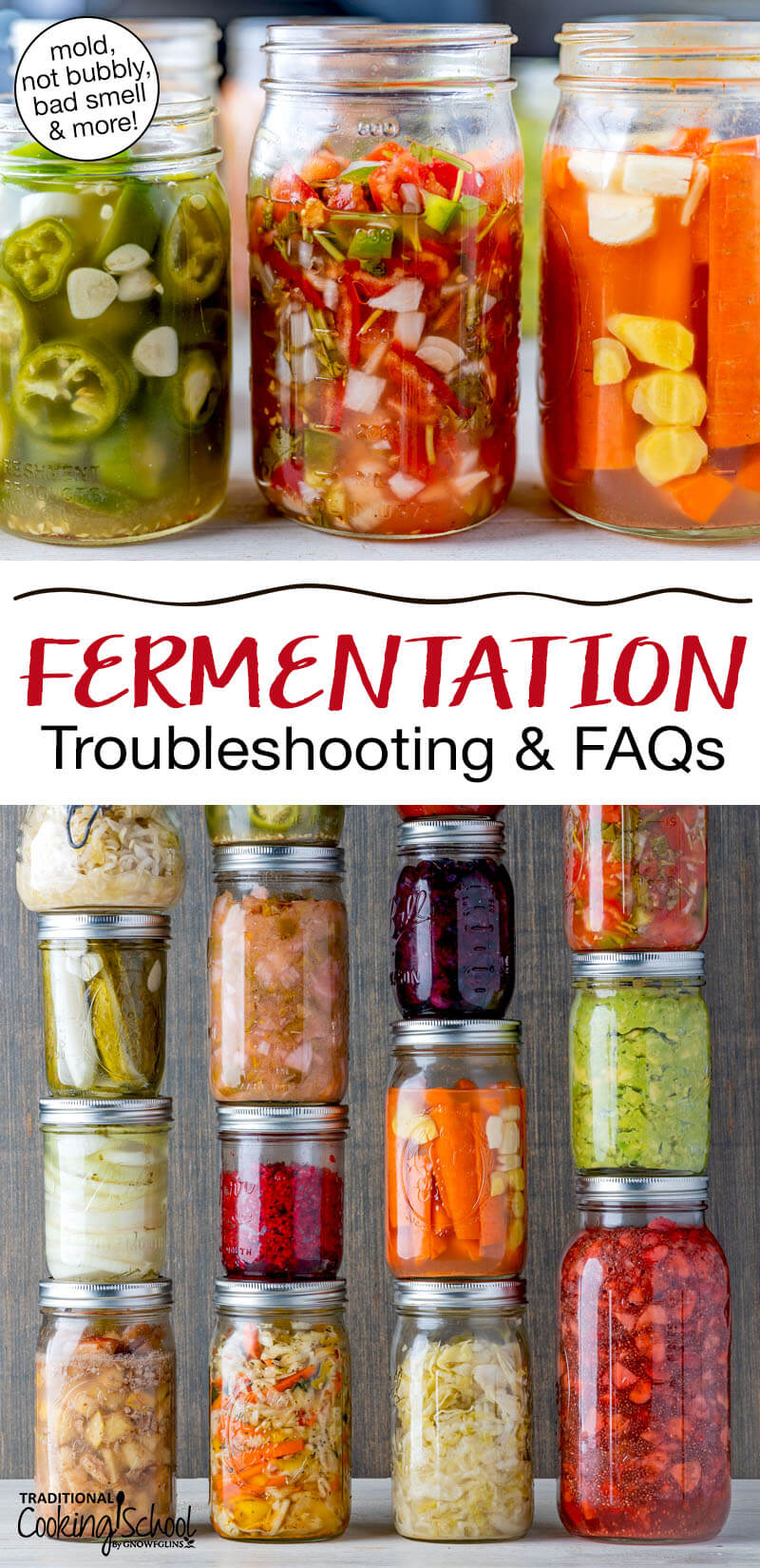
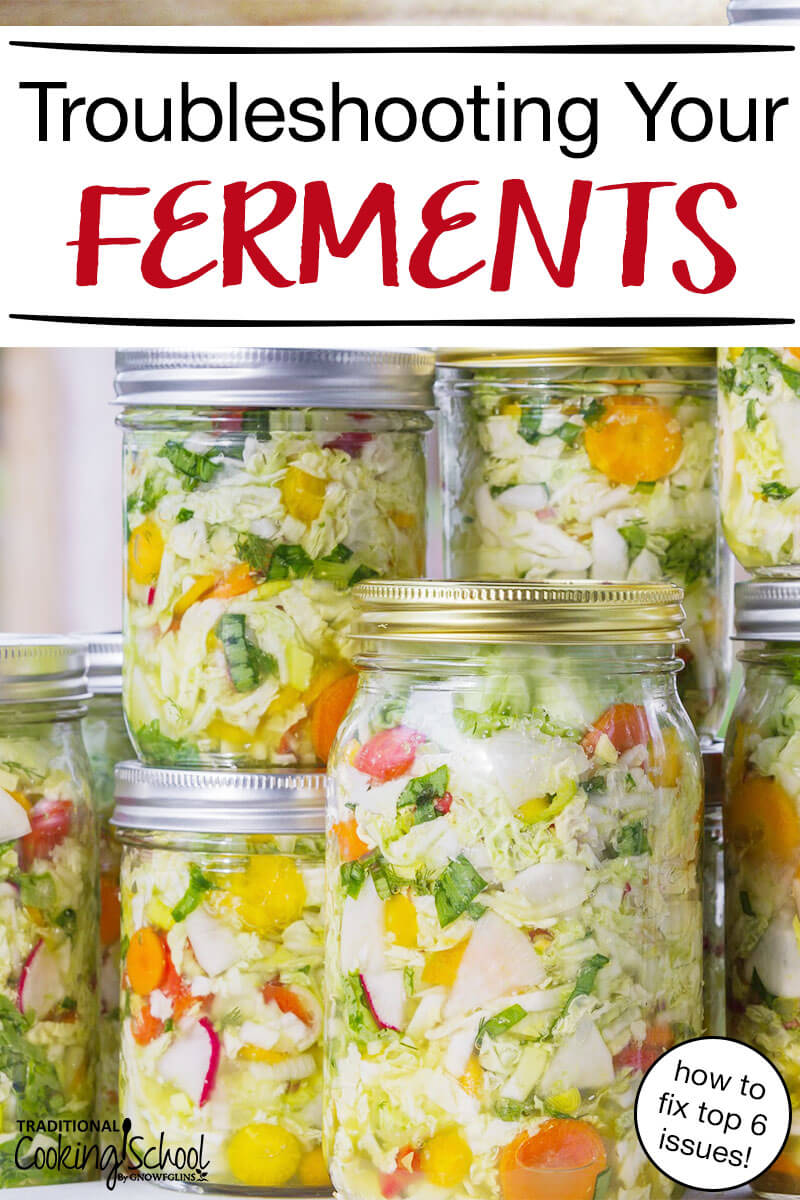
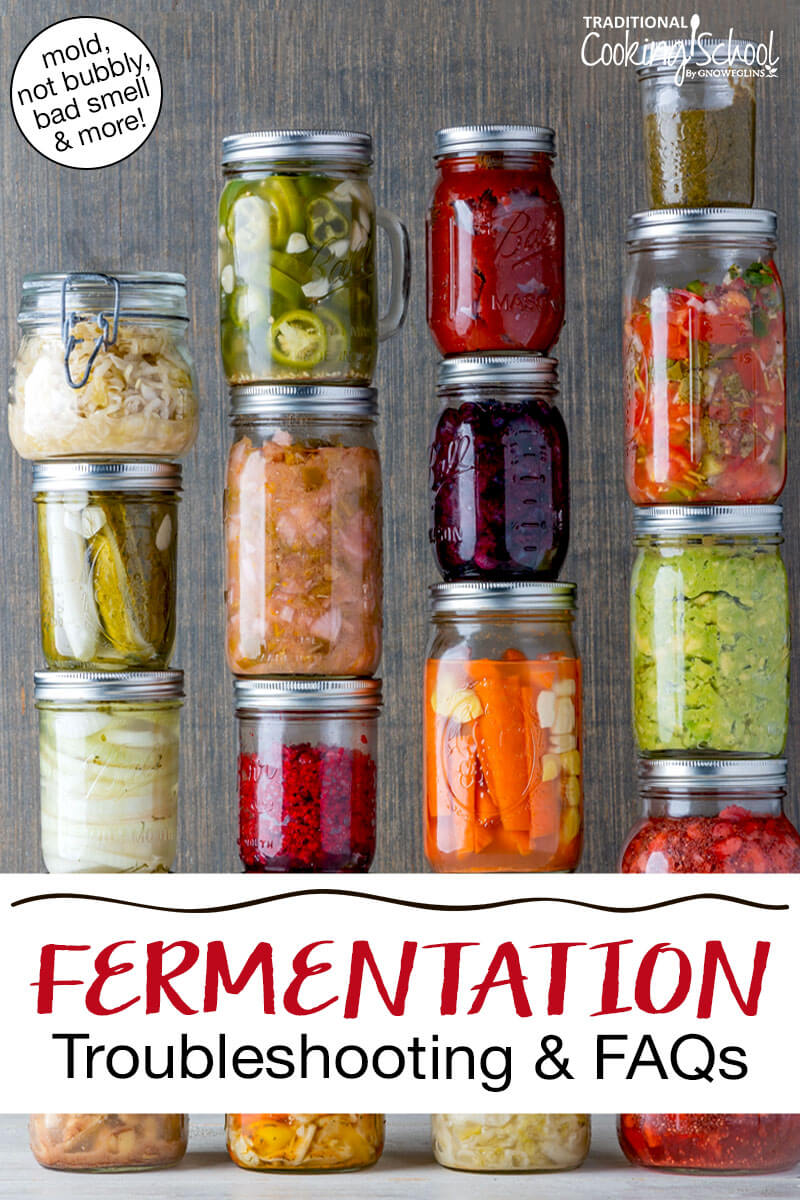
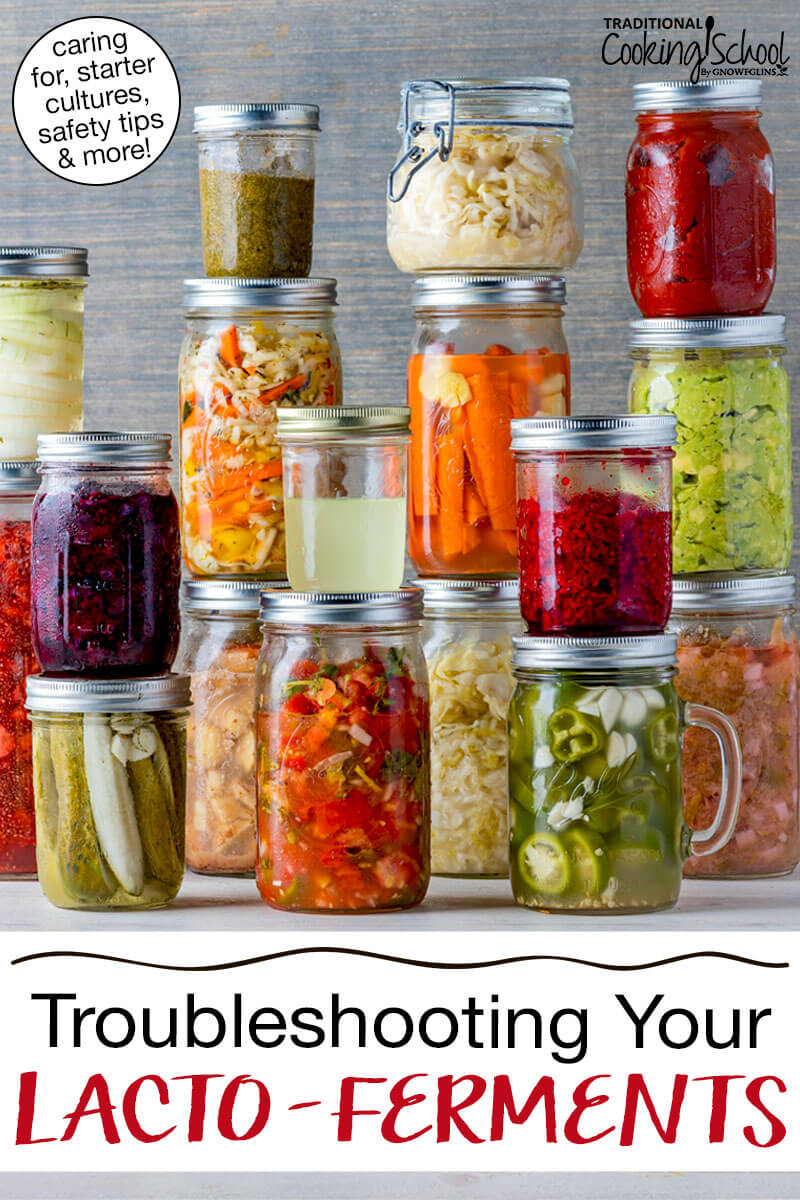
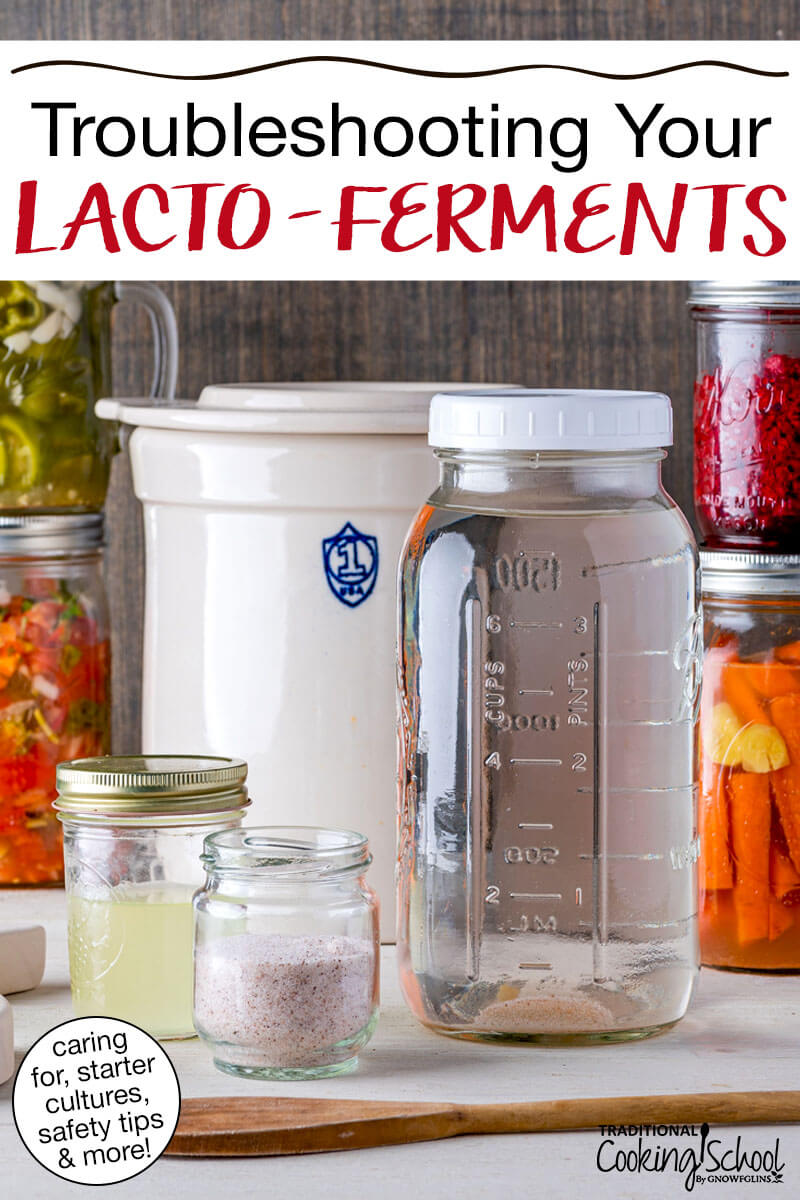
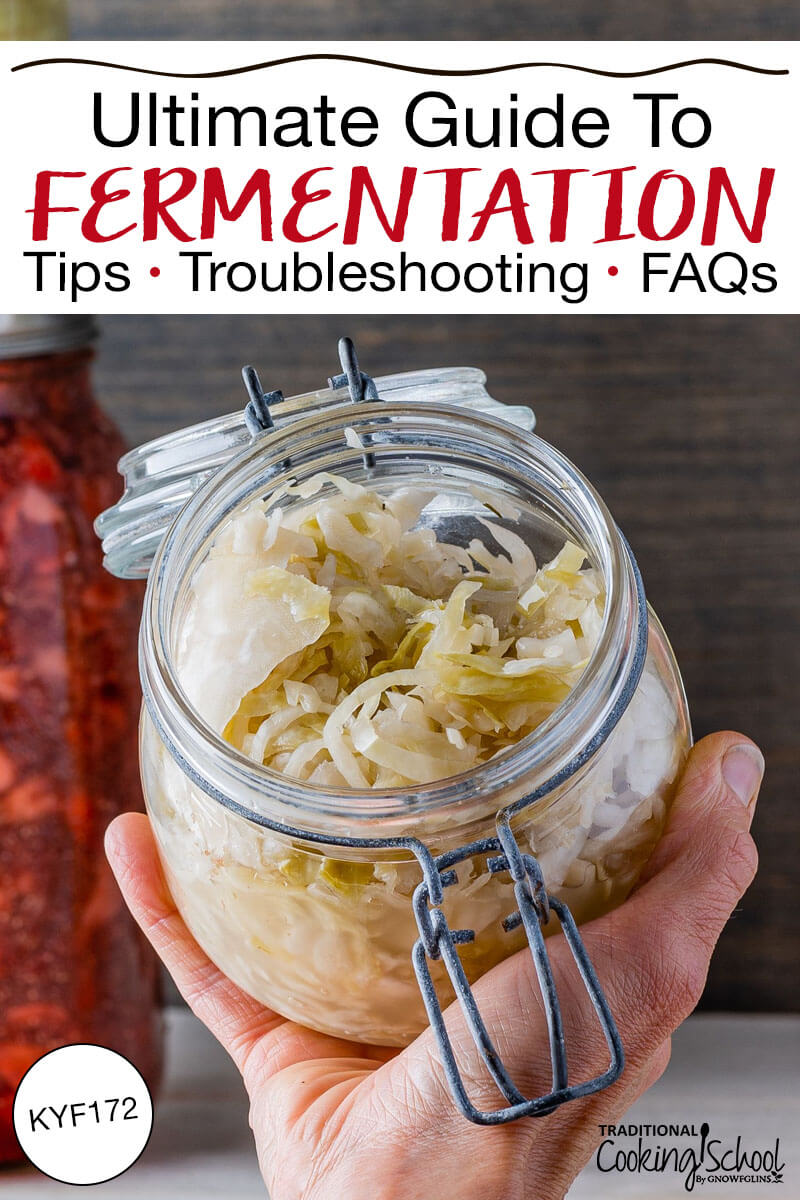
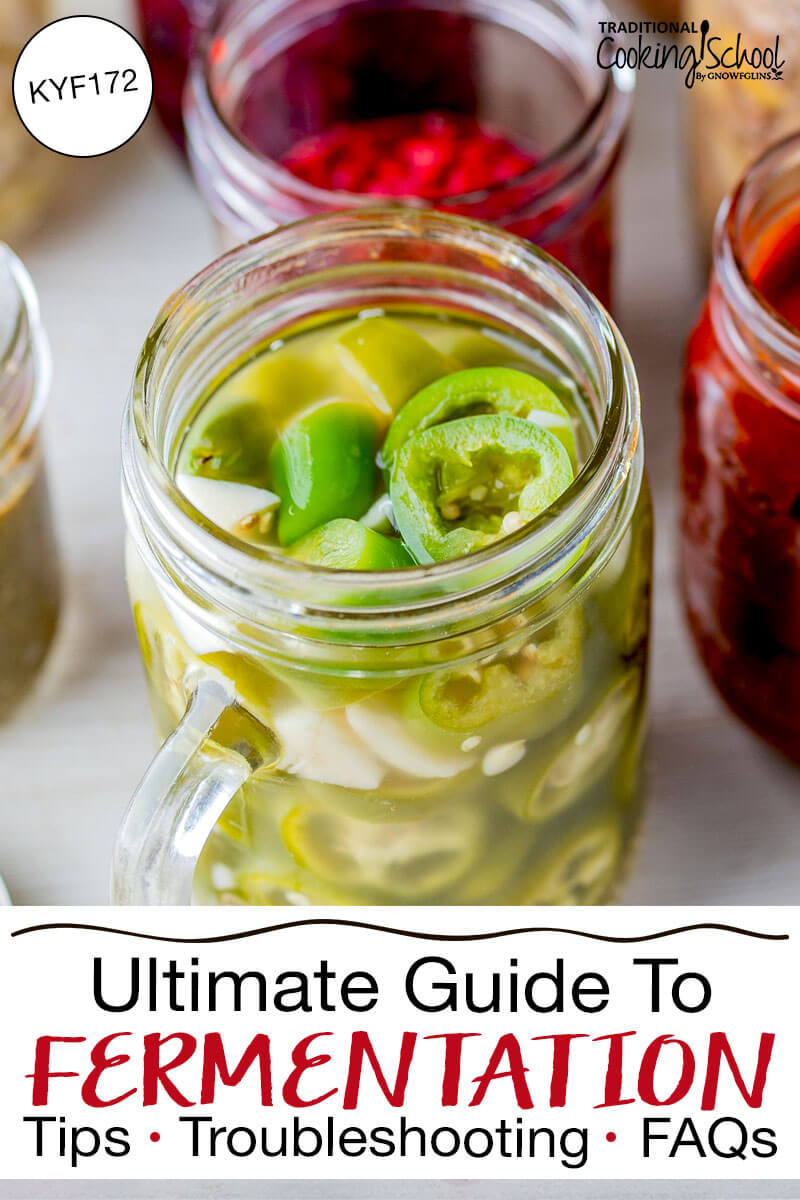
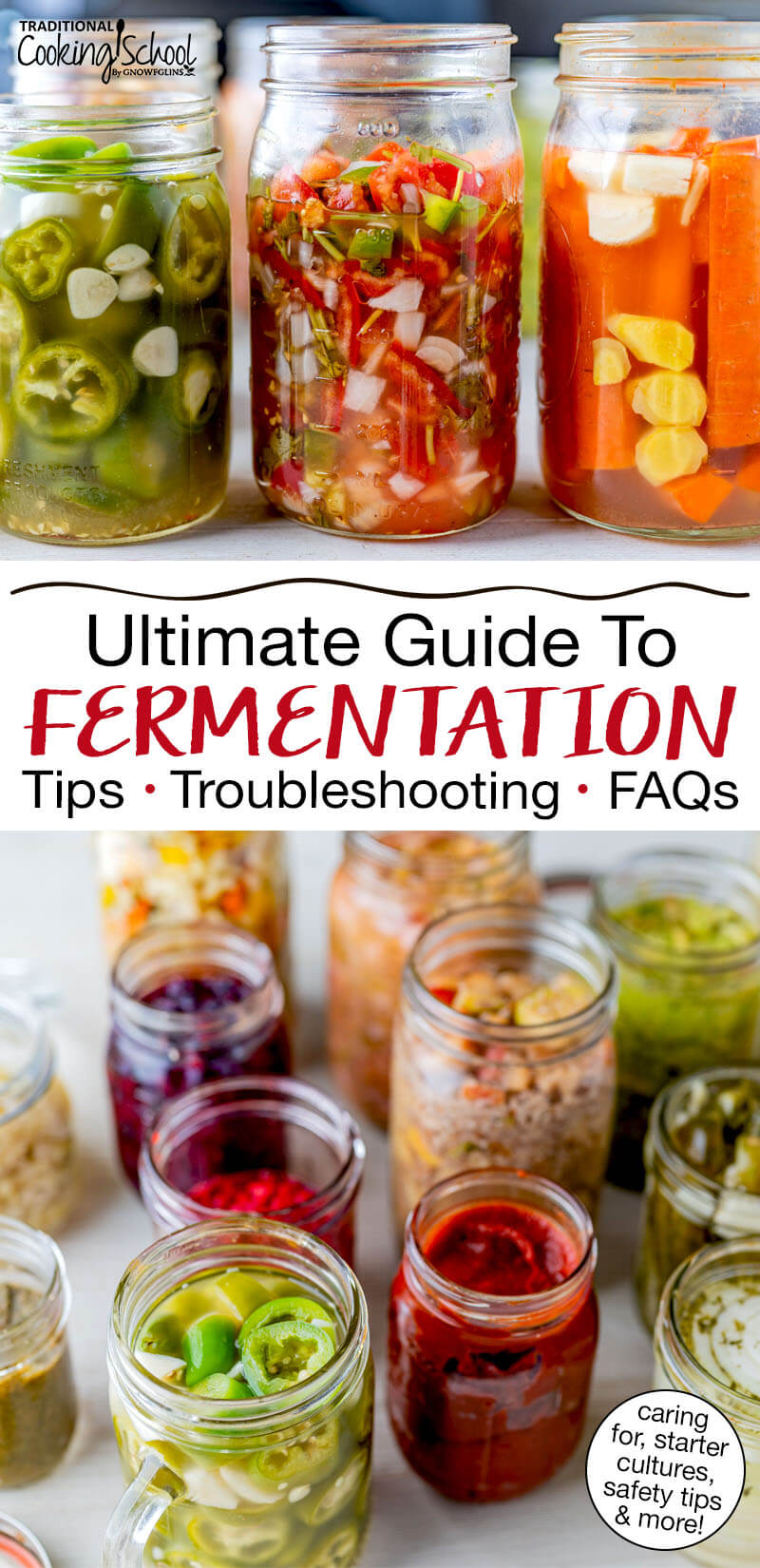
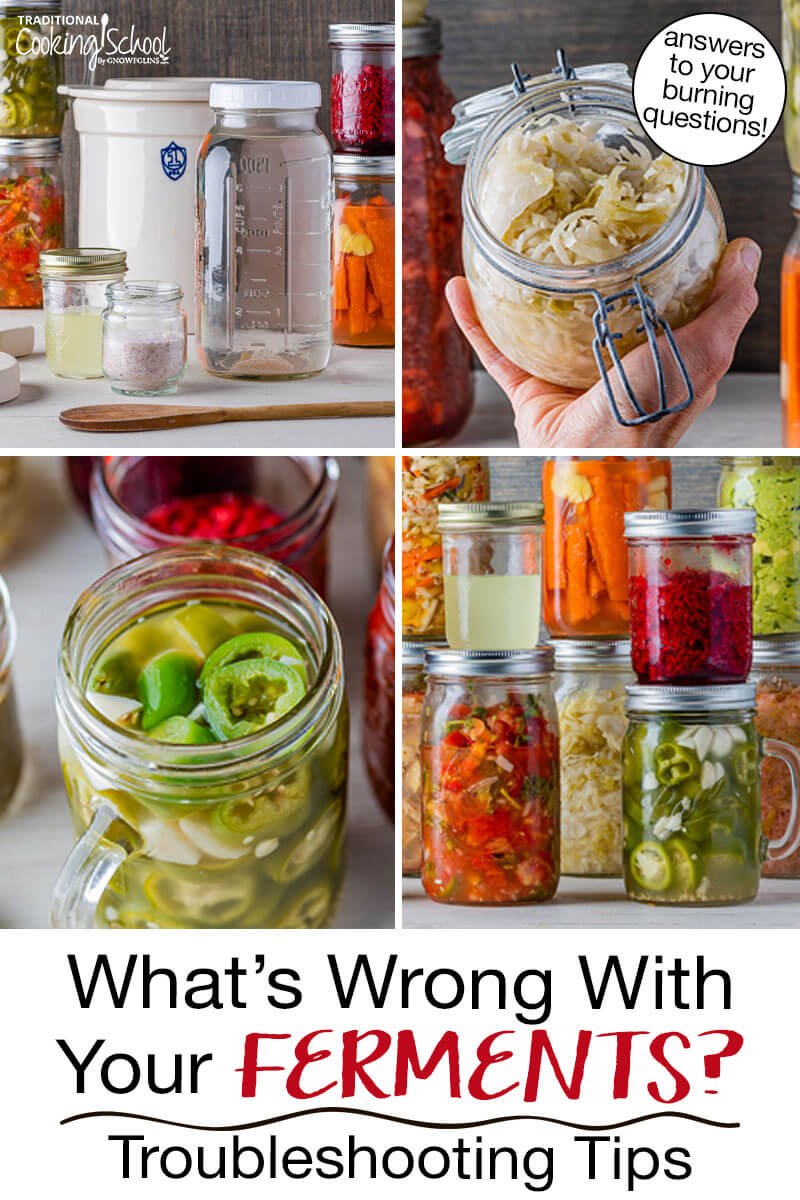

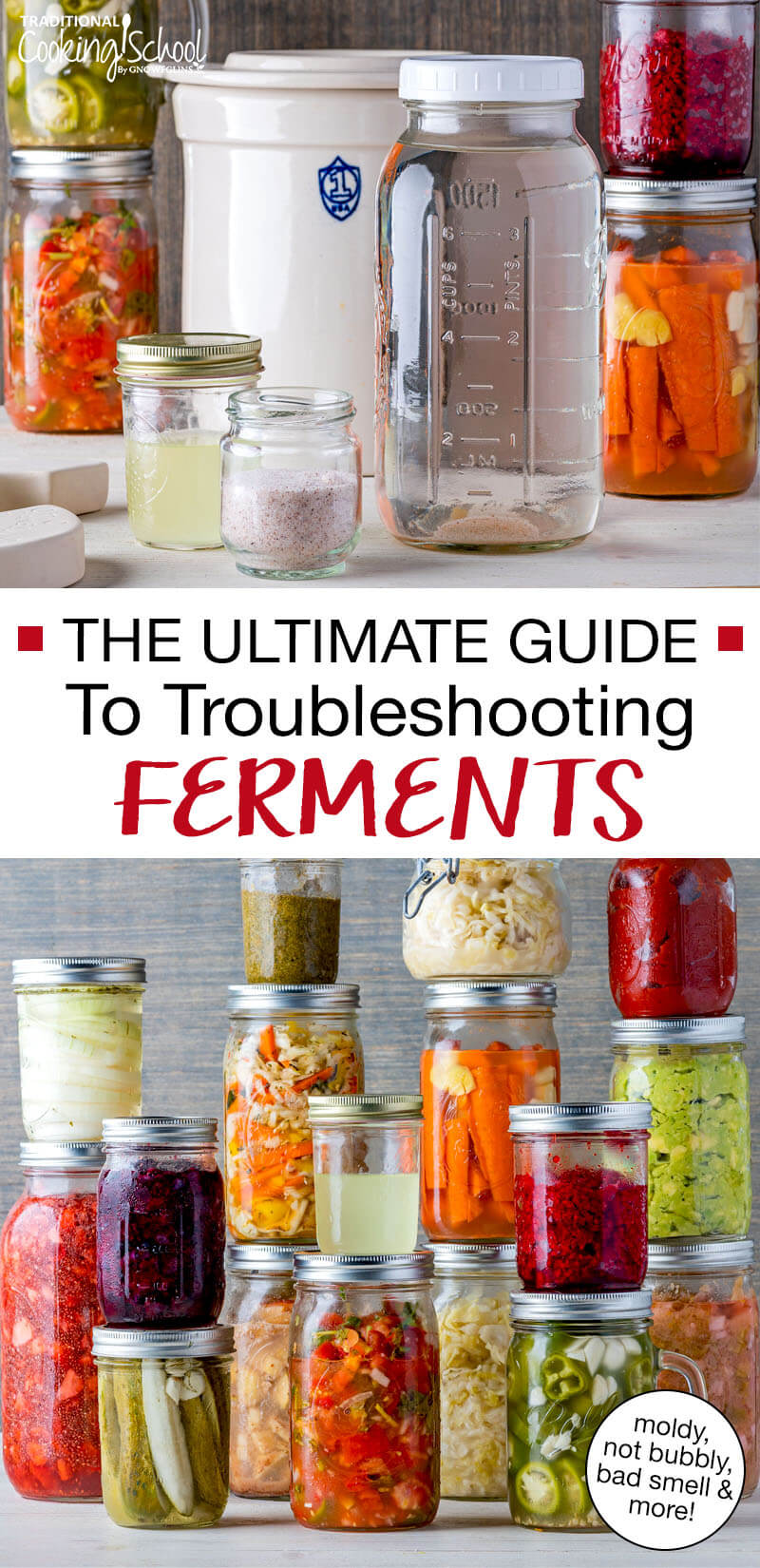
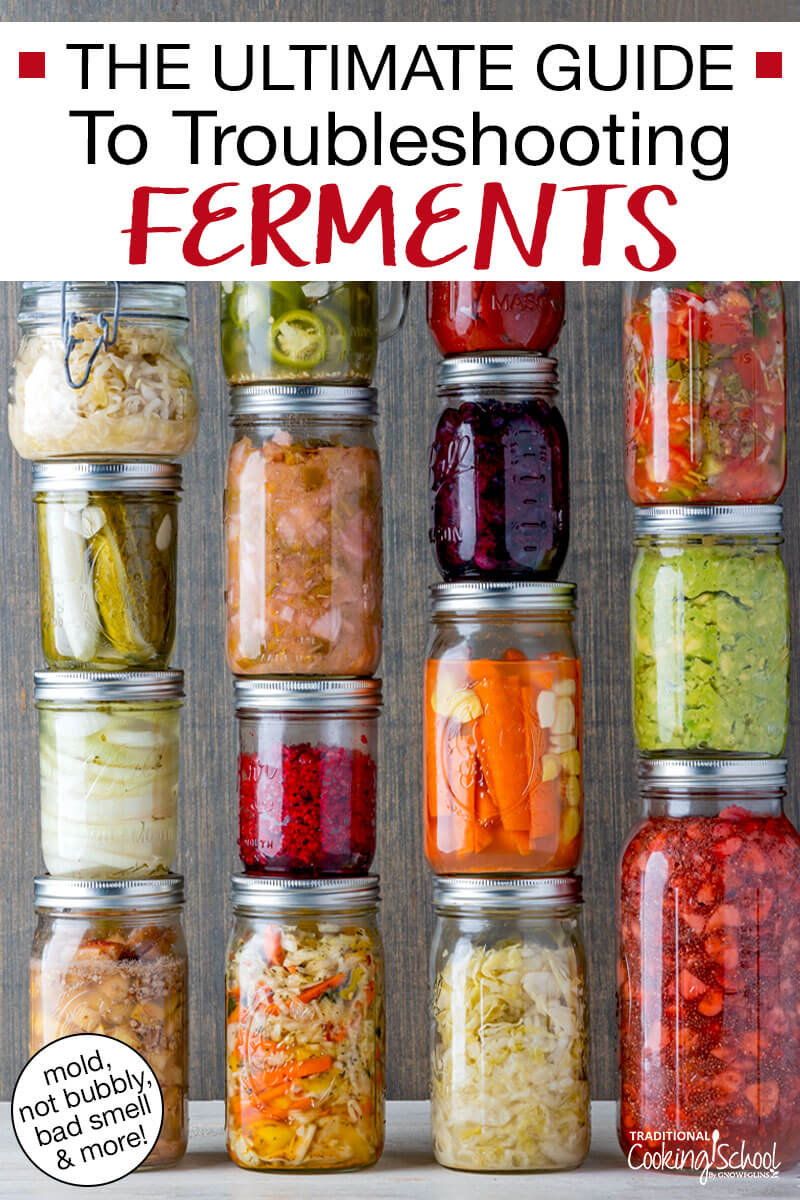
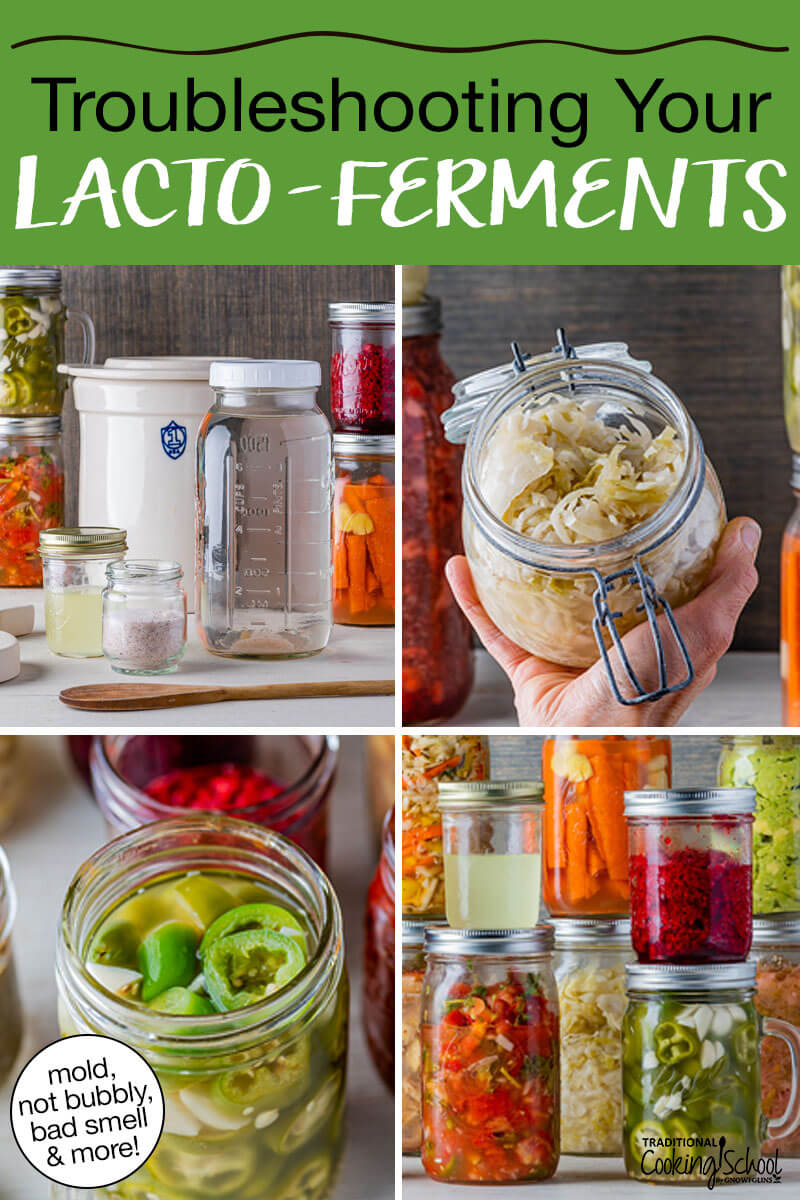
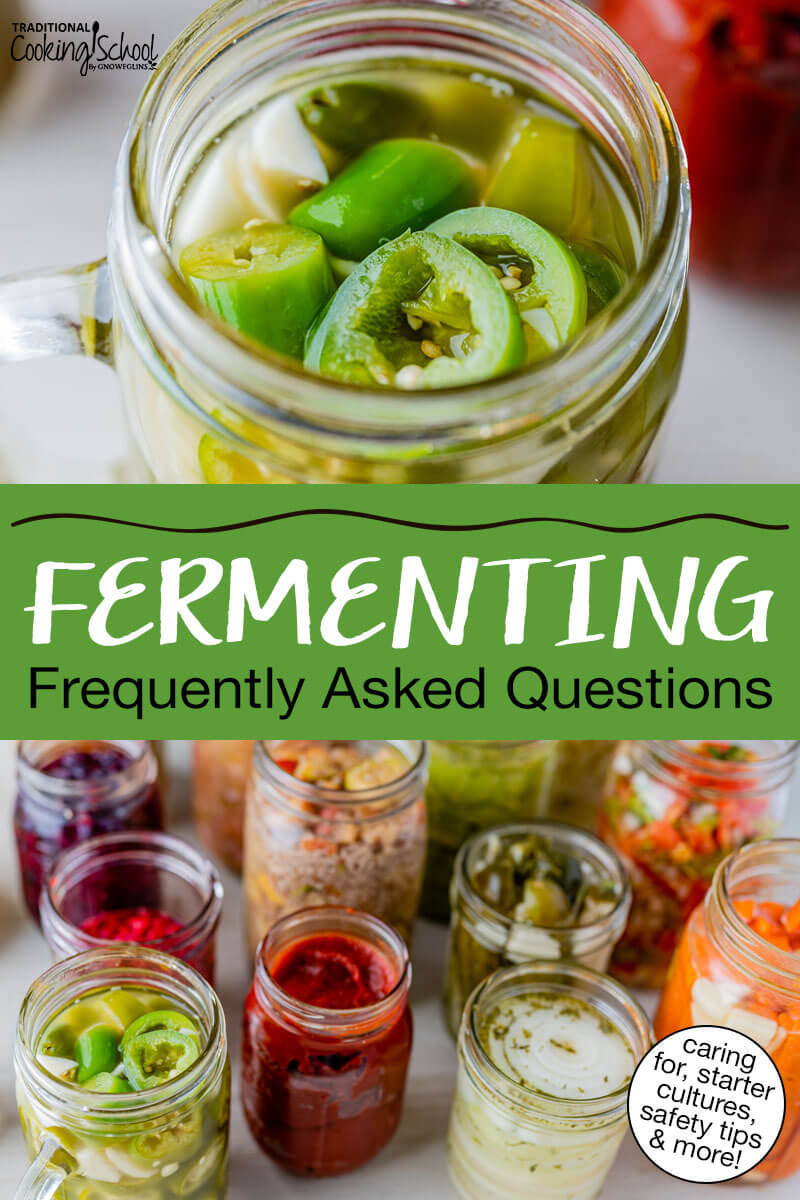
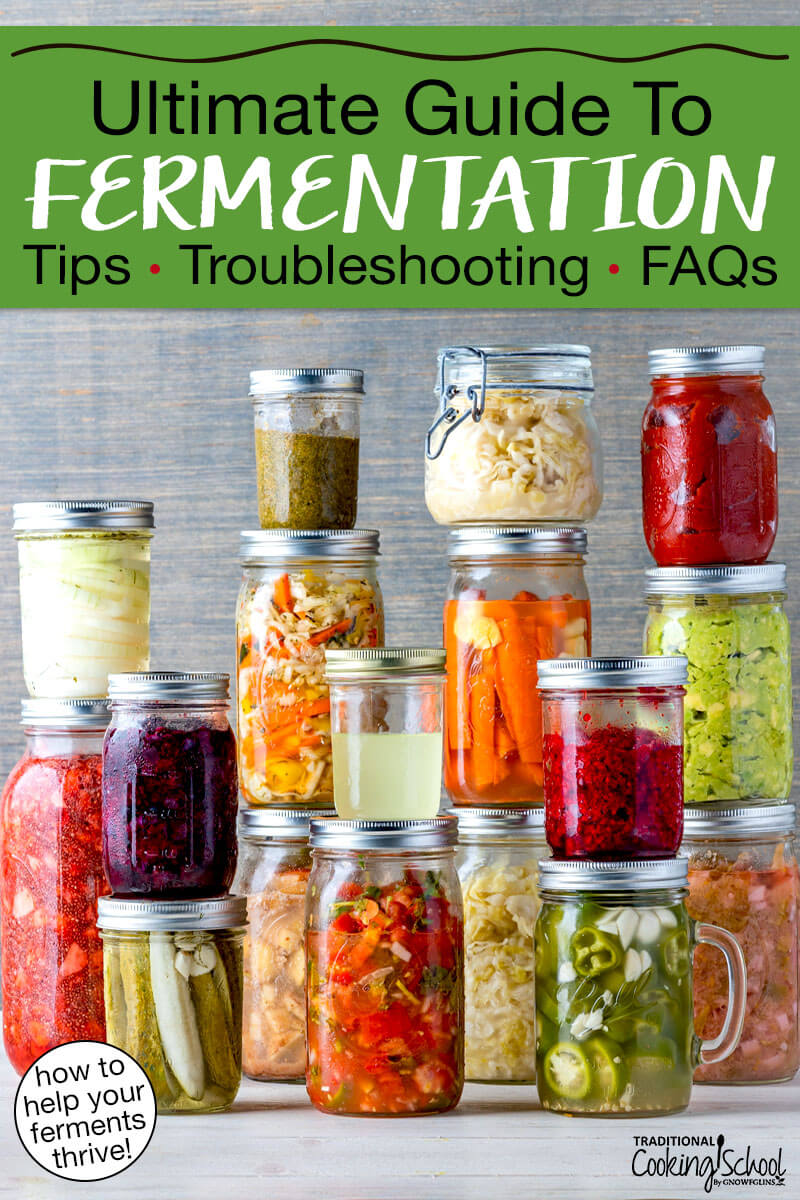
Hi Wardee and Team. When you made that additional 1 spoon salt in a cup of water, must the water be boiled, hot, warm or cold?
I have a 5 Lt jar that I made a concoction of cabbage, carrots, green & yellow peppers, onions, cucumber and Jalapeno Peppers with some Peppadew Peppers as well. I added some mustard seeds and Pickling Spices. My question: Is it ok that I am just adding more veggies to the bottle as I remove and eat the contents or should I boil up extra liquid. There is a lot of liquid, white vinegar, in the bottle and the veggies come to the surface as there is more liquid than veggies.
Thank, Frances from Sunny South Africa
Hi Frances,
For the additional brine, to top off, the water doesn’t need to be boiled (unless that is your usual practice to clean water). It should be cold or room temp when combining with the salt.
Is your concoction fermented or vinegar-pickled? If it’s vinegar-pickled, we really don’t know as we’re not familiar with that method. If it’s fermented, yes, you can keep adding additional veggies to the jar and they will ferment too. (Though more slowly if it’s in the fridge.) Add more brine as needed so everything stays covered.
Millie
Traditional Cooking School
My problem concerns the odor of the utensils (glass jars, lids) after consuming all of a given batch of ferment and then cleaning them as thoroughly as I can.
The tangy smell of the ferment clings to the glass jars and permeates the entire cupboard in which
they are stored. It got so bad that my fermenting experiment was banned from the kitchen.
I used the recipes and methods in “The Complete Idiot’s Guide to Fermenting..”
Hi Scott,
You could boil the utensils for 2 minutes or try cleaning with vinegar or baking soda.
Millie
Traditional Cooking School
Hi Millie,
I will try that… I did put them in the dishwasher which did not make the odor disappear.
Thanks,
Scott
In this video it is mentioned that if your liquid settles when storing you can use saved brine from an older batch of sauerkraut. Earlier when discussing pickles and kraut it is mentioned to help keep them crunchy using a veggie starter culture rather than whey. So my question is could I use older brine as a veggie starter culture?
Hi Jeannine,
You can use your previous brine as for your new ferment. Keep your flavors in mind. You may not want to use a pickle brine for a fruit ferment. 🙂
Millie
Traditional Cooking School
I just made some kimchi (salt brine, no whey) and it tastes and smells great. This time around, though, the veggies are a bit soft. Not slimy or extremely mushy, but not crispy like last time. Is there any reason it would be unsafe to eat? I’m going to make more (I’ve made it a dozen times and it’s always had a crunchy texture), but I hate to waste what we already have. Thanks!!
Hi Justyn,
They may have fermented a little too long which is why you are missing the crunch. As long as they are not slimy and smell good they are safe to eat. 🙂
Millie
Traditional Cooking School Support
Thank you so much Wardee! I am so glad I discovered you! I am new to fermenting did my first sauerkraut and while fermenting I didn’t cover it with a lid and the fermenting is going slow it’s been 8 days should I cover it with a tight lid and let it ferment for couple more days or toss it? I missed that I have to cover it with a tight lid, it doesn’t smell bad and crunchy but not sizzling. I really like the one I get from Trader Joes it’s sizzling and it doesn’t make my stomach achy.
Hi Iaplandka,
It’s better with a lid, but if it’s doing ok, cover it now and keep going. Some people ferment sauerkraut for a month. Wardee prefers about a week. It’s up to preference and of course, making sure it is doing all the right things. 🙂
~Millie, TCS Customer Success Team
I made a basic cabbage ferment for sauerkraut, cabbage and pink salt, which I’ve done before. I have a gallon sized airlock jar that I packed it in after getting a good amount of brine from the cabbage. about 24 hrs after I closed the jar the brine overflowed. Ive never had this happen before. usually I can barely get enough to cover the cabbage, but this time the level kept rising in the jar. Is it just because of the water content of the cabbage I started with?
Hi Jennifer,
It may have been cabbage with more water. Also, during summer months (warm weather) ferments can happen much faster and be more aggressive. The combination of both can cause an overflow problem.
~ Millie, TCS Customer Success Team
I found this on makesauerkraut.com about salt ratio slowing, speeding up or making the ferment slimy.
The amount of salt you mix with your cabbage and vegetables determines the salinity of the fermentation environment. The best quality sauerkraut is made with 2-2.5% salt. This calls for mixing
1 tablespoon of salt with 1 ¾’s pounds (28 ounces, 800 grams) cabbage and vegetables, or
3 tablespoons of salt for 5 pounds (2400 grams, 2.4 kilogram) of cabbage and vegetables.
Too little salt speeds up the fermentation and might produce soft or slimy kraut. Adding too much salt slows down the fermentation and will inhibit the growth of the lactic acid bacteria, just the bacteria you want.
I, too, have made kraut and it is slimy. Is that safe to eat and why does it happen? I use 5 pounds of cabbage and 3 T canning salt.
Hi, Mikki,
Yeast can cause it to be slimy. It is probably safe to eat. Your taste and smell will guide you. I would try again and see if it happens again. Some ferments that I make all the time sometimes do not turn out for one reason or another just the way I like it (not often but sometimes). Canning salt is not what we like to use for the salt. We prefer real salt with color. If you could use that instead, that would be better.
~Peggy, TCS Customer Success Team
My Apple Cider Vinegar smells like paint thinner, which means it was fermenting at a temperature that was too high. Does this mean I need to throw it out?
Hi, Ilaine: Based on what Wardee shares in this post, if your ACV smells like paint thinner, I would throw it out and start again, keeping in mind that your temperature might be two warm and it needs a cooler place to ferment. —Sonya, TCS Customer Success Team
Hello,
I attempted a chutney ferment that used kombucha as a starter from a recipe where I swapped fresh mango for the fresh plums the recipe called for.
I let it ferment for a few days like the recipe called for and I just reached the part where I’m supposed to put a lid on it and keep it in the fridge and I’ve found that it has a layer of mold on top.
There are visible bubbles lower in in the jar, if I remove a good portion of the top is it ok to eat the rest?
Also the recipe didn’t specify to use an airlock so I just covered with a paper towel and a rubber band, would using an airlock prevent this from happening in future?
Best regards,
Marie.
Hi, Marie,
I am sorry your chutney has mold on top. You will find this post very helpful:
https://traditionalcookingschool.com/food-preparation/how-to-prevent-mold-during-fermentation-aw074/
The next time you ferment I would use an airlock or something similar as in these types of ferments we want to keep the oxygen out as best we can for the best results. 🙂
~Peggy, TCS Customer Success Team
Precisely what I was searching for, thanks for posting.
Can municipal water containing chloramine be boiled for 20 minutes to remove the chloramine, and then use that water to ferment foods?
Hi Ann, We have a link about water filtration options here: https://traditionalcookingschool.com/food-preparation/kitchen-tools/exploring-water-filtration-options/?swcfpc=1
We also found this link that talks about removing chlorine/chloramine which seems to indicate you need to boil the water for 60 minutes: https://aquanswers.com/does-boiling-water-remove-chlorine-chloramine/
Hope this helps. ~ Vicki, TCS Customer Success Team
I HAVE RECENTLY MADE A CROCK OF KRAUT. IT IS THE FIRST TIME I HAVE USED THE NEW CHURN WITH A WATER SEAL. IT HAS BEEN SITTING FOR 1WK. THE LID IS FLOATING UP FROM THE GASES. I TOOK THE LID OFF TO LET THE GASES ESCAPE AND THEN REPLACED IT. IS THIS NORMAL? IT DOES HAVE A NOTCH IN THE LID FOR GASES TO ESCAPE. I WAS WONDERING DO I HAVE TOO MUCH WATER AROUND THE RIM OR IS THIS NORMAL? I WAS ALSO TOLD THAT SINCE I REMOVED THE LID I SHOULD SCRAPE OFF THE BUBBLES. CAN YOU HELP AND TELL ME WHAT I NEED TO DO NEXT. DO I NEED TO LET IT SIT OR CONTINUE TO TAKE LID OFF EVERY SO OFTEN AND SCRAPE OF THE BUBBLY STUFF? THANKS
SABRINA
Hi Sabrina, I think you’re doing a great job! Sometimes it is necessary to “burp” your container to release gases. Bubbles are a sign that fermenting is occurring. You don’t need to remove the bubbles. You just want to make sure your kraut is under the brine. Continue to ferment your kraut until you think it ready usually 5 – 7 days. Here’s another post that may help you: https://traditionalcookingschool.com/food-preparation/how-to-make-sauerkraut-in-a-stoneware-crock/
Enjoy! ~ Vicki, TCS Customer Success team
Just wondering about when I put my ferments into cold storage – can I remove my weights to use for other ferments or do I need to leave them in the jars until we eat them? I have dozens of jars I want to put up for winter but don’t know how to keep them all weighted if that’s what’s needed.
Hi, Christa.
Yes, you can remove the weights. 🙂
~Danielle, TCS Customer Success Team
Great post. thanks for sharing.
Great! I learned a lot from your experience. I did try some tips from you. That help me much. Thank you for sharing much!
Hi! I made a fermented salsa and we have been eating it for about 2 weeks. It is in the refrigerator but the last two days when I open the jar it is extremely active! Bubbles up very aggressively, but tastes fine, if not just a little extra fermenty…is this normal or ok? I’ve made other ferments that are in the fridge for months now with no activity like that.
Hi, Christine: As long as the salsa smells and tastes fine, it’s good! And the beneficial organisms must be very happy! I’ve never been able to keep salsa around that long to see if that might happen. 🙂 —Sonya, Customer Success Team
Hello, Wardee
I’m making soda with a ginger-bug.
What is the sediment on the bottom of the bottle… if my 2nd-ferment? Is it yeast? Is it safe?
Hi, Joe,
Here is a link you might find helpful: http://fermentmakers.com/white-stuff-at-bottom-of-ginger-bug/
~Peggy, TCS Customer Success Team
I’m fermenting colored small carrots. the color has gone out of ALL the carrots..Just wondering why..
Thank you,Sarah
Hi, Sarah,
This can happen during the fermenting process. Some lose their color more than others.
~Peggy, TCS Customer Success Team